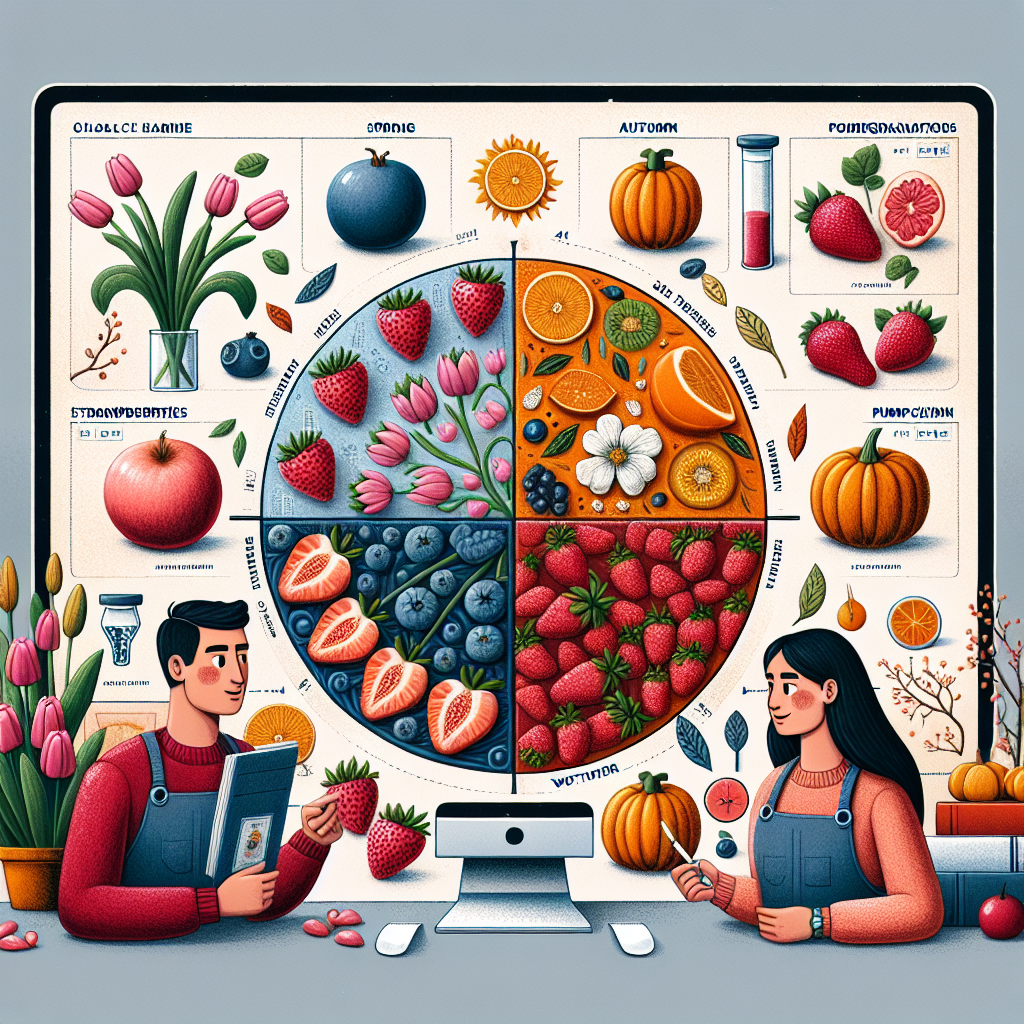In today’s article, we will explore the fascinating concept of seasonal fruits and shed light on what makes them so special. When nature’s bounty gifts us with an array of delicious fruits, have you ever wondered why certain fruits are available only during specific times of the year? By understanding the factors behind their seasonality, we can not only make more informed choices about the fruits we consume but also immerse ourselves in the beauty and flavors of each season. So, get ready to embark on a fruity adventure as we unravel the secrets of seasonal fruits together!
Understanding Seasonal Fruits

What Makes a Fruit Seasonal?
When we talk about seasonal fruits, we refer to those that are available at a particular time of the year when they are naturally harvested. Unlike fruits that are available year-round, seasonal fruits are influenced by the climate, weather patterns, and agricultural practices. The changing seasons affect the growth and ripening cycles of fruits, making them available during specific periods. Understanding what makes a fruit seasonal is key to appreciating the benefits and importance of consuming them.
Benefits of Consuming Seasonal Fruits
eating seasonal fruits comes with numerous benefits for both our health and the environment. Firstly, seasonal fruits are often fresher and have higher nutritional value. Since they are harvested at the peak of their ripeness, they have more vitamins, minerals, and antioxidants compared to fruits that have been stored for longer periods. Additionally, seasonal fruits are typically more flavorful, making them a delight to eat.
Consuming seasonal fruits also supports local farmers and the community. By buying fruits that are in season, you are directly supporting local agricultural practices and contributing to the local economy. It helps maintain food traditions, encourages local farming diversity, and preserves the cultural heritage of a region.

Factors Affecting Fruit Seasonality
Several factors influence the seasonality of fruits. The most significant factor is the climate and weather patterns. Different fruits have specific temperature and weather requirements for their growth and ripening. For example, citrus fruits like oranges and lemons thrive in warmer climates, while apples and pears prefer cooler temperatures.
Agricultural practices and farming techniques also play a role in determining fruit seasonality. Farmers may use methods such as controlled environments, greenhouses, or hydroponics to extend the growing season of certain fruits. However, these practices are not always sustainable or accessible to everyone, which further emphasizes the importance of consuming locally grown seasonal fruits.
Different Types of Seasonal Fruits
Seasonality varies depending on the geographical location and climate. In temperate regions, fruits like apples, pears, cherries, and berries are commonly available during the spring and summer months. Tropical regions offer fruits such as mangoes, pineapples, and papayas year-round due to their consistently warm climate. In autumn, fruits like pumpkins, squash, and grapes are abundant.
It’s important to keep in mind that the availability and seasonality of fruits can differ in different regions due to variations in climate and agricultural practices. Consulting local farmers, food guides, or visiting farmers’ markets can provide valuable insights into the seasonal fruits specific to your area.

Importance of Eating Locally Grown Seasonal Fruits
Opting for locally grown seasonal fruits is not only beneficial for your health but also for the environment. When you choose fruits that are grown locally, you are reducing the carbon footprint associated with transporting and storing fruits over long distances. It promotes sustainable agricultural practices and reduces greenhouse gas emissions.
Consuming locally grown seasonal fruits also fosters a sense of connection to your community and the land. It allows you to appreciate the efforts of local farmers and the fruits of their labor. By supporting local farmers, you contribute to the preservation of agricultural heritage, protect farmland from urban development, and promote biodiversity.
The Nutritional Value of Seasonal Fruits
Seasonal fruits are powerhouses of essential nutrients that are crucial for maintaining a healthy diet. They are rich in vitamins, minerals, fiber, and antioxidants. Each fruit has its own unique nutritional composition, offering a diverse range of health benefits.
For example, berries like strawberries and blueberries are packed with antioxidants that help fight inflammation and protect against chronic diseases. Citrus fruits like oranges and grapefruits are excellent sources of vitamin C, which boosts the immune system and aids in collagen production. Watermelon, with its high water content, keeps you hydrated During hot summer months while providing essential vitamins and minerals.
By consuming seasonal fruits, you are giving your body the opportunity to benefit from the optimal nutrient content that these fruits naturally offer.

Tips for Buying and Storing Seasonal Fruits
To make the most out of your seasonal fruit shopping experience, here are a few tips to keep in mind:
-
Familiarize yourself with the seasonal fruits in your area by consulting local farming guides or websites.
-
Visit farmers’ markets for the freshest and most diverse selection of seasonal fruits. You can also connect with local farmers, ask questions, and gain insights into their farming practices.
-
Look for fruits that are firm, fragrant, and free from blemishes or bruises. If possible, choose organic options to minimize exposure to pesticides.
-
Properly store your seasonal fruits to maintain their freshness. Some fruits can be stored at room temperature while others require refrigeration. Avoid washing fruits until just before consumption to prevent premature spoilage.
By following these tips, you can ensure that you enjoy the best quality and flavor from your seasonal fruits.
Recipes Using Seasonal Fruits
Seasonal fruits offer endless possibilities when it comes to culinary creativity. Here are a few recipe ideas to inspire you:
-
Fresh Strawberry Salad: Toss together fresh strawberries, mixed greens, goat cheese, and a balsamic vinaigrette for a refreshing and flavorful salad.
-
Grilled Peach Salsa: Grill sliced peaches, then combine them with diced tomatoes, red onions, jalapeños, cilantro, and lime juice for a sweet and spicy salsa that pairs perfectly with grilled meats or as a dip.
-
Apple Cinnamon Overnight Oats: Combine rolled oats, almond milk, chopped apples, cinnamon, and a drizzle of honey in a jar. Let it sit overnight in the refrigerator for a delicious and nutritious breakfast.
-
Mango Coconut Smoothie: Blend ripe mangoes, coconut milk, Greek yogurt, and a squeeze of lime for a tropical and creamy smoothie that energizes your day.
Feel free to experiment with seasonal fruits in your favorite recipes, incorporating them into desserts, main dishes, or even homemade jams and preserves. The possibilities are endless!

Sustainable Farming Practices for Seasonal Fruits
In recent years, there has been an increased focus on sustainable farming practices to ensure the long-term availability of seasonal fruits. Sustainable farming aims to minimize the negative impact of agriculture on the environment while maximizing the yield and nutritional content of crops.
Some sustainable farming practices include:
-
Organic farming: Avoiding the use of synthetic pesticides and fertilizers, organic farming promotes soil health, biodiversity, and the prevention of environmental pollution.
-
Crop rotation: By rotating crops, farmers can prevent the depletion of nutrients in the soil, reduce the risk of pests and diseases, and improve overall farm productivity.
-
Water conservation: Implementing techniques like drip irrigation and rainwater harvesting minimizes water waste and ensures efficient water use on farms.
-
Integrated pest management: This approach focuses on controlling pests by using natural predators, good agricultural practices, and targeted interventions, reducing the need for harmful chemical pesticides.
By supporting farmers who practice sustainable farming methods, you contribute to the preservation of the environment and the future availability of seasonal fruits.
The Impact of Globalization on Seasonal Fruit Availability
With the increase in global trade and transportation, the availability of seasonal fruits has been greatly impacted. While globalization has made it possible for us to enjoy fruits from all over the world, it has also led to certain challenges.
Transportation of fruits over long distances requires significant energy consumption and contributes to greenhouse gas emissions. Additionally, some regions may prioritize exporting their seasonal fruits to support their economies, which can result in limited availability and higher prices in local markets.
Furthermore, globalization has also led to the loss of regional food traditions and the homogenization of diets. With the convenience of year-round fruit availability, people may not fully appreciate the unique flavors and nutritional benefits that come with consuming locally grown seasonal fruits.
It is important to strike a balance between enjoying the fruits that globalization brings while also supporting local farmers, preserving biodiversity, and reducing our environmental impact.
In conclusion, understanding seasonal fruits helps us appreciate the benefits they offer and the impact of our choices on our health and the environment. By opting for locally grown seasonal fruits, we support sustainable farming practices, enjoy fresher and more nutritious produce, and connect with our community and culinary heritage. So next time you’re at the grocery store or farmers’ market, embrace the opportunity to choose and enjoy the abundance of seasonal fruits available to you.

